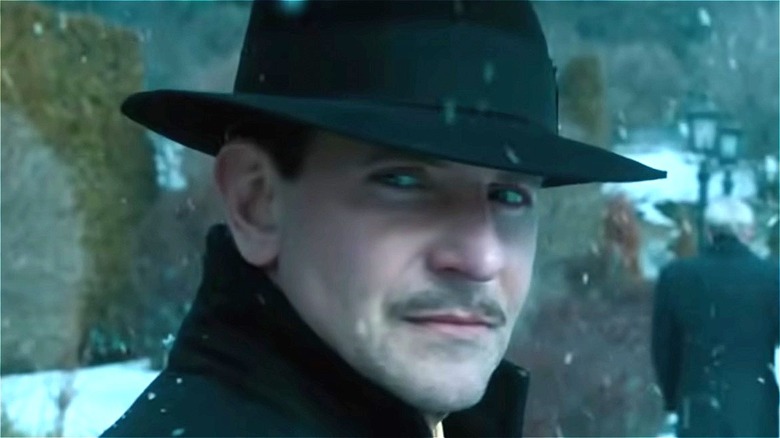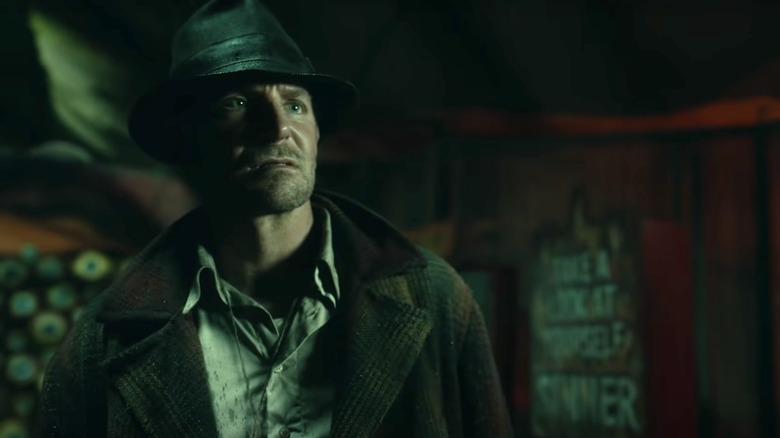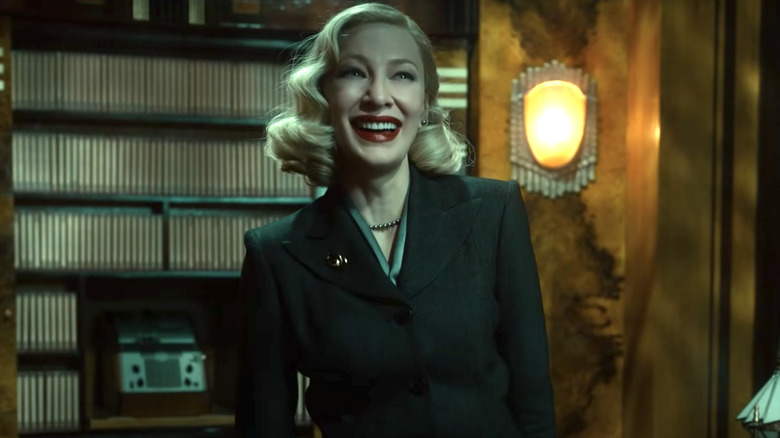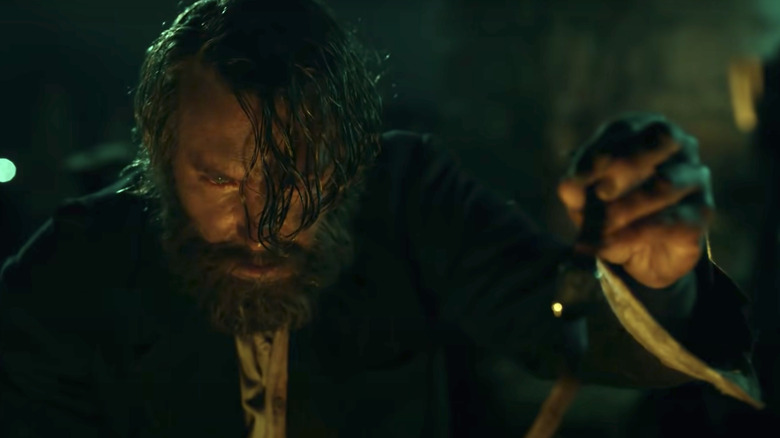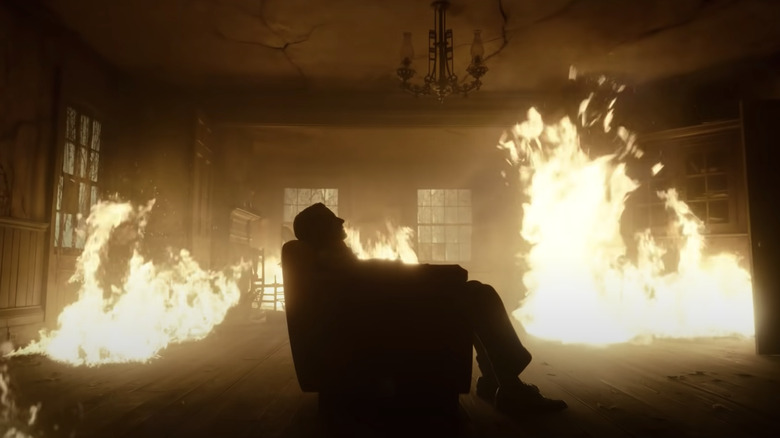The Ending Of Nightmare Alley Explained
Guillermo del Toro's "Nightmare Alley" is a violent and intense film about the dangers of ambition and greed, and how important it is to know oneself. Based on William Lindsay Gresham's 1946 novel of the same name, the film follows the adventures of Stanton "Stan" Carlisle (Bradley Cooper) as he makes the transition from being a worker at a modest carnival to being a successful and popular mentalist. Directed with del Toro's trademark, dreamlike visual style, the film is a noir epic that feels increasingly more nightmarish the further into its 150-minute runtime it gets.
Nowhere are the dark themes and noir influences of "Nightmare Alley" more apparent than in its brutal final act, which sees its protagonist's arrogance and lies catch up with him in truly tragic fashion. Unlike the Tyrone Power-led 1947 adaptation of "Nightmare Alley," which softens its source material's ending by concluding on an optimistic and compassionate note, del Toro's version sticks closer to Gresham's unflinchingly bitter and cynical original finale.
Indeed, the film ends on a shot that should prove difficult for anyone who seeks it out to forget. It's the moment in which del Toro's "Nightmare Alley" comes full circle, and not only does it bring Stanton Carlisle's journey to a fitting end, it also redefines and casts everything that came before it in an entirely new light.
Poor souls
When audiences meet Bradley Cooper's Stanton Carlisle at the start of "Nightmare Alley," he's dragging a body across a floor only to ultimately burn both it as well as the house it resides in. The film's first act then follows Stan as he joins up with a circus run by the cunning Clem Hoately (Willem Dafoe). One night, Clem demands that Stan help him dispose of the carnival's "geek," a performer who is kept in a cage, treated like an animal, and forced to bite the necks of live chickens in front of jeering crowds.
After leaving the carnival's geek passed out in front of a doctor's office, Clem takes Stan out for breakfast. Once there, Stan asks Clem how anyone could be convinced to take on the job of a geek. In answer to his inquiry, Clem explains that he usually picks out someone who is down on their luck that he finds in the street and tells them that he might have a job for them. He convinces them to temporarily become the carnival's geek in exchange for shelter and alcohol, which they don't realize Clem is lacing with opium. Once he's decided that the person is sufficiently addicted to their carnival lifestyle, Clem abuses and manipulates them until they completely lose their sanity and dignity and become a "real geek."
Stan disgustedly listens to Clem's explanation, unable to understand how any human being could be driven to such depths. Stan, who proudly tells anyone who will listen that he never drinks or does drugs, believes himself to be above the desperation of others. As a result, he fails to recognize how a person could find themselves in the kind of position Clem has just described to him.
If you or anyone you know is struggling with addiction issues, help is available. Visit the Substance Abuse and Mental Health Services Administration website or contact SAMHSA's National Helpline at 1-800-662-HELP (4357).
A kindred spirit
In the second act of "Nightmare Alley," Stan Carlisle crosses paths with Dr. Lilith Ritter (Cate Blanchett), a skeptical and egotistical psychologist who tries, at first, to embarrass Stan during one of his mentalist performances. Stan, however, ends up getting the better of her.
Days later, he shows up in Lilith's office with a simple proposal: If she uses her position as a wealthy psychologist to give him insider information about some of New York's most powerful people, he'll give her part of the money he earns using said information to perform readings with her clients. Lilith agrees to Stan's terms under one condition: He has to participate in therapy sessions with her. Stan agrees, not realizing that Lilith intends to do the one thing he can't let her: break down his defenses and reveal who he really is.
She does just that too, forcing Stan to confront his hatred of his father, whom he murdered just before the start of the film. Playing into his ego, Lilith reveals Stan's savagery and arrogance. She subtly manipulates him into drinking alcohol for the first time, and in doing so, pushes him headfirst down the path that he set himself on. She knows that, like so many tragic figures before him, Stan not only doesn't see others as well as he thinks he does, but he also fails to see who he truly is: a liar who is afraid to face himself.
A real geek
In the end, Stanton Carlisle's arrogance comes back to haunt him. Not only does Lilith Ritter betray him, but his girlfriend, Molly Cahill (Rooney Mara), leaves him and he is forced to go on the run for the murder of a sociopathic client he and Lilith conned together. It's a series of events, all of which are set into motion by his own decisions, that result in Stan becoming a homeless alcoholic who sleeps in train cars and trades in his most precious belongings for bottles of alcohol.
Ultimately, in the final scene of "Nightmare Alley," Stan tries to climb back up from rock bottom by approaching the owner of a carnival (played by Tim Blake Nelson) about joining his crew as a mentalist. The man rejects Stan's proposal, but gives him a glass of opium-laced alcohol and offers him a temporary job as the carnival's geek. Stan, realizing he is being played in the exact way Clem told him about many years before, begins to cry and laugh at the same time. He drinks the alcohol that was just given to him, and when the circus owner asks how he feels about being a geek, Stan responds, "I was born for it."
After spending the entire film building himself up and engaging in a constant pursuit of power, Stan ends up becoming the very thing he always considered himself to be better than. It's an undeniably powerful and tragic conclusion to his story.
Stanton Carlisle's journey is a cautionary tale
Throughout "Nightmare Alley," Guillermo del Toro includes shots of Bradley Cooper's Stanton Carlisle sleeping in the same room that he killed his father in and burned down in the film's first scene. While we don't know it at first, it becomes clear that Stan is trapped in a cage from the moment he first appears on-screen in "Nightmare Alley."
Of course, what makes Stan's journey truly powerful is that he's a character who is, ultimately, undone by his own greed, ambition, and inability to recognize his faults and weaknesses. It's his mercenary attempts to accrue power and wealth that lead to him bleeding out on top of single dollar bills in Lilith Ritter's office, and it's his refusal to address his own humanity that results in him ending up trapped in a cage and treated like an animal.
As Guillermo del Toro observed in an interview with Esquire, Stan's journey is like "the American version" of a Greek tragedy. In the latter kind of story, del Toro wisely notes that "destiny is something that is imposed upon you." Stan's downfall, however, "comes from the decisions of man." In other words, Stan's journey over the course of "Nightmare Alley" is uniquely American because it's one that is constantly shaped and guided by the decisions he makes in an effort to elevate himself above others.
"We give him all the tools to be happy in the movie, quite literally we hand him a happy ending over and over," del Toro said. "But he wants more and it's not enough." As a result, "Nightmare Alley" concludes with Stan ending up exactly where he's always been: a prison of his own making. The only difference is that, this time, everyone knows that's where he is, including him.
